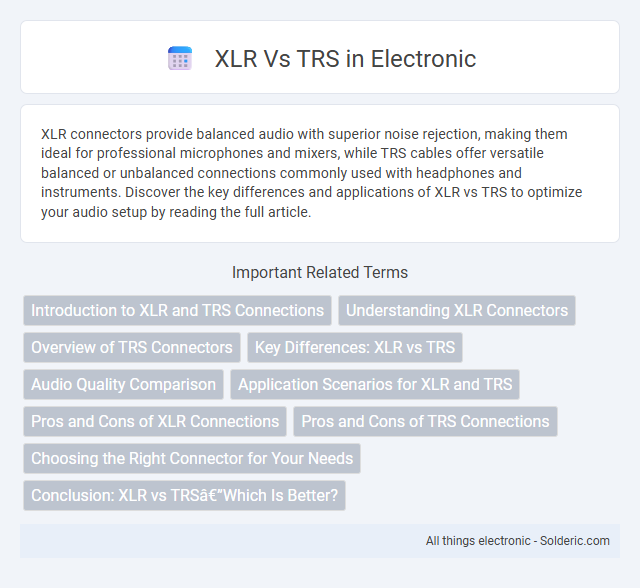XLR connectors provide balanced audio with superior noise rejection, making them ideal for professional microphones and mixers, while TRS cables offer versatile balanced or unbalanced connections commonly used with headphones and instruments. Discover the key differences and applications of XLR vs TRS to optimize your audio setup by reading the full article.
Comparison Table
| Feature | XLR | TRS |
|---|---|---|
| Connector Type | 3-pin balanced audio connector | Tip-Ring-Sleeve 1/4" or 1/8" jack |
| Signal Type | Balanced audio signal | Balanced or unbalanced audio signal |
| Common Usage | Professional microphones, audio equipment | Instruments, headphones, some line-level devices |
| Durability | Robust metal construction, locking mechanism | Less rugged, no locking mechanism |
| Cable Length Support | Supports long cable runs with minimal noise | Best for short to medium cable lengths |
| Phantom Power Support | Yes, commonly used for condenser microphones | No, generally not supported |
| Impedance | Low impedance | Varies, generally higher impedance |
Introduction to XLR and TRS Connections
XLR and TRS connectors are essential in professional audio for balanced signal transmission, reducing noise and interference. XLR connectors typically feature three pins and are widely used for microphones and high-quality audio equipment. TRS connectors, resembling standard headphone jacks with Tip-Ring-Sleeve contacts, serve both balanced mono and unbalanced stereo signals in various audio applications.
Understanding XLR Connectors
XLR connectors feature a robust three-pin design commonly used in professional audio equipment for balanced audio signals, reducing noise and interference during transmission. These connectors provide secure, locking connections ideal for microphones, mixers, and high-end audio interfaces. Their durable metal casing and reliable contact pins ensure consistent signal quality in live sound and studio recording environments.
Overview of TRS Connectors
TRS connectors, also known as Tip-Ring-Sleeve connectors, are commonly used for balanced audio signals and stereo unbalanced connections due to their three contact points. These connectors help reduce noise and interference by providing a balanced connection, making them ideal for professional audio equipment and musical instruments. Your sound setup benefits from TRS connectors by maintaining signal integrity over longer cable runs compared to unbalanced alternatives.
Key Differences: XLR vs TRS
XLR connectors feature three pins and a locking mechanism, providing secure, balanced audio connections ideal for professional microphones and high-quality sound equipment. TRS connectors have a tip-ring-sleeve design that supports balanced or stereo signals, commonly used for headphones, instruments, and line-level audio devices. Understanding these key differences helps you choose the right connector based on your audio setup's needs for stability, signal interference reduction, and compatibility.
Audio Quality Comparison
XLR connectors deliver superior audio quality due to their balanced design, which effectively reduces electromagnetic interference and noise, ensuring clear and pristine sound in professional audio environments. TRS connectors, while also balanced, often experience slightly higher susceptibility to noise over long cable runs, making them less ideal for critical studio recordings compared to XLR cables. The robust locking mechanism of XLR cables further enhances signal integrity, maintaining consistent audio quality during live performances and studio sessions.
Application Scenarios for XLR and TRS
XLR connectors dominate professional audio environments such as live sound, studio recording, and broadcast due to their balanced design, which minimizes noise and interference over long cable runs. TRS connectors are commonly used for balanced line-level signals in smaller setups like home studios, headphone outputs, and instrument connections where shorter cable lengths reduce noise susceptibility. Choosing between XLR and TRS depends on application needs, with XLR preferred for robust, high-quality audio transmission and TRS suited for compact, flexible audio interfaces.
Pros and Cons of XLR Connections
XLR connections provide superior audio quality and balanced signal transmission, making them ideal for professional audio equipment and long cable runs due to reduced noise and interference. Their robust, lockable design ensures secure connections, but XLR connectors tend to be bulkier and more expensive than alternatives like TRS cables. However, the complexity and cost can be a drawback for casual or home audio setups where simplicity and affordability are prioritized.
Pros and Cons of TRS Connections
TRS connections offer balanced audio signals, reducing noise and interference in professional audio setups. They are versatile and compatible with various devices, supporting both stereo and balanced mono signals, but their durability is typically lower than XLR connectors due to less robust locking mechanisms. TRS cables also have shorter cable length limitations and may experience signal degradation over long distances compared to XLR cables.
Choosing the Right Connector for Your Needs
XLR connectors provide balanced audio signals with superior noise rejection, making them ideal for professional microphones and longer cable runs. TRS connectors also offer balanced audio but are more common in instruments and shorter connections, offering compact and versatile use. Your choice depends on the equipment compatibility and the environment's susceptibility to interference.
Conclusion: XLR vs TRS—Which Is Better?
XLR connectors provide balanced audio signals with superior noise rejection, making them ideal for professional microphone and audio equipment connections. TRS connectors also offer balanced audio but are more commonly used for shorter cable runs and line-level signals. Choosing between XLR and TRS depends on Your specific audio setup, with XLR often preferred for high-quality, noise-sensitive applications.
XLR vs TRS Infographic

 solderic.com
solderic.com